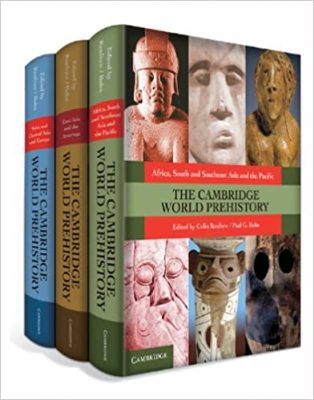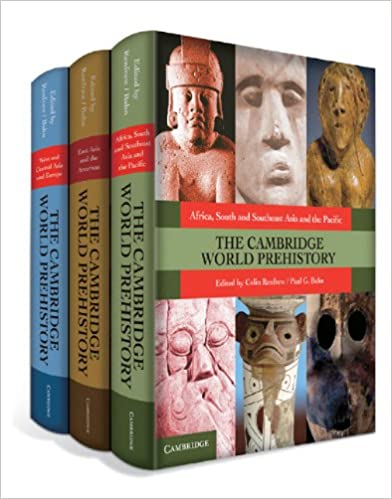 Editors: Colin Renfrew and Paul G. Bahn
Editors: Colin Renfrew and Paul G. Bahn
Publisher: Cambridge University Press – 2,049 total pages
Book Review by: Nano Khilnani
What is the Cambridge World Prehistory in 3 Volumes?
- It is essentially an authoritative and systematic examination of:
- The prehistory of every region around the world
- From the early days of human origins in Africa two million years ago
- To beginnings of written history, which in some areas began just two centuries ago
The three volumes of this prehistory include:
- Both traditional topics and cutting-edge approaches
- Such as archaeological linguistics and molecular genetics
- And essential questions of human development around the world
The volumes are organized:
- Geographically, exploring the evolution of hominins and their expansion from Africa,
- As well as the formation of states, and the development in each region of
- Technologies such as sea-faring, metallurgy, and food production
The Cambridge World Prehistory in 3 Volumes
- Reveals a rich and complex history of the world
- Is an invaluable reference for any student and scholar of archaeology,
- And related disciplines looking to research a particular topic, tradition, or region
- Within prehistory
One hundred and two contributors (102) from all over the world authored the various chapters of this work. They are from 22 countries: Argentina, Australia, Belgium, Canada, Egypt, France, Germany, India, Indonesia, Israel, Mexico, the Netherlands, New Zealand, Philippines, Russia, Spain, Scotland, South Africa, Thailand, Turkey, the United Kingdom, and the United States.
The contributors are in a large range of diverse occupations: they are anthropologists, archaeologists, architects, authors, doctors, Egyptologists, historians, journalists, professors, researchers, scientists, and writers. They are specialists in the various arts, cultures, humanities, legal fields, and various science fields: the anatomical sciences, engineering, ethnography, ethnology, health sciences, and much, much more.
This work of 2,049 pages consists of three books with the following titles:
Volume 1 – Africa, South and Southeast Asia and the Pacific – Pages 1 to 690
Volume 2 – East Asia and the Americas – Pages 691 to 1353
Volume 3 – West and Central Asia and Europe – Pages 1354 to 2049
Volume 1–Africa, South and Southeast Asia and the Pacific – Pages 1 to 690 – Contents:
- INTRODUCTION
- Introduction
- Introduction: DNA
- Introduction: Languages
- AFRICA
- Early Hominins
- Earliest Industries of Africa
- The Human Revolution
- The Genus Homo in Africa
- Becoming Human: Archaeology of the Sub-Saharan Middle Stone Age
- The Later Stone Age of Southern Africa
- Prehistory in North Africa after the Middle Paleolithic
- Holocene Prehistory in West Africa
- The Archaeology of the Central African Rainforest: Its Current State
- The Later Prehistory of Southern Africa from the Early to the Later Iron Age
- The Prehistory of East Africa
- Neolithic and Predynastic Egypt
- The Emergence of the Egyptian state
- Pharaonic History
- Summary of Classical and Post-Classical Africa
- Africa: Languages
- SOUTH AND SOUTHEAST ASIA
- The Paleolithic of South Asia
- The Early Paleolithic of Southeast Asia
- South and Southeast Asia: DNA
- The Upper Paleolithic of South and Southeast Asia
- Post-Pleistocene South Asia: Food Production in India and Sri Lanka
- The Indus Civilization
- India beyond the Indus Civilization
- Historic India
- Early Food Production in Southeast Asia
- Complex Society in Prehistoric Mainland Southeast Asia
- Summary of Historic Mainland Southeast Asia
- Prehistory of the Indonesian Archipelago
- The Philippines
- South and Island Southeast Asia: Languages
- THE PACIFIC
- The Pacific: DNA
- Sahul and Near Oceania in the Pleistocene
- New Guinea during the Holocene
- The Later Prehistory of Australia
- Micronesia
- Melanesia
- Polynesia
- New Zealand
- The Pacific Languages
Volume 2 – East Asia and the Americas – Pages 691 to 1353 – Contents:
- EAST ASIA
- East Asia: DNA
- Early Paleolithic of Central and Northern Asia
- The Upper Paleolithic of Northeast Asia
- Early Sedentism in East Asia: From Late Paleolithic to Early Agricultural Societies in Insular East Asia
- The Neolithic of Northern and Central China
- The Neolithic of Southern China
- Early Complex Societies in Northern China
- Early Complex Societies in Southern China
- China from Zhou to Tang
- Complex Society in Korea and Japan
- The Later Prehistory of the Russian Far East
- East Asia: Languages
- THE AMERICAS
- The Americas: DNA
- Initial Peopling of the Americas: Context, Findings, Issues
- Paleo-Indian and Archaic Periods in North America
- The Paleo-Indian and Archaic of Central and South America
- The Archaic and Formative Periods of Mesoamerica
- Agricultural Origins and Social Implications in South America
- The Basin of Mexico
- The Olmec, 1800-400 BCE
- Oaxaca
- The Origins and Development of Lowland Maya Civilization
- Early Coastal South America
- The Development of Early Peruvian Civilization
- Styles and Identities in Central Andes: The Early Intermediate Period and Middle Horizon
- The Later Intermediate Period and Late Horizon
- Ecuador, Colombia, and Venezuela
- Prehistory of Amazonia
- Argentina and Chile
- The Caribbean Islands
- The Southwestern Region of North America
- The Pacific Coast of North America
- The Great Plains and Mississippi Valley
- Eastern Atlantic Coast
- Northern North America
- The Americas: Languages
Volume 3 – West and Central Asia and Europe – Pages 1354 to 2049 – – Contents:
VII – WESTERN AND CENTRAL ASIA
- The Early Prehistory of Western and Central Asia
- Western and Central Asia: DNA
- The Upper Paleolithic and Early Epi-Paleolithic of Western Asia
- The Origins of Sedentism and Agriculture of Western Asia
- The Levant in the Pottery Neolithic and Chacolithic Periods
- Settlement and Emergent Complexity in Western Syria, C.7000-2500 BCE
- Prehistory and the Rise of Cities n Mesopotamia and Iran
- Mesopotamia: The Historical Periods
- Anatolia: From the Pre-Pottery Neolithic to the End of the Early Bronze Age (10,500 – 2000 BCE)
- Anatolia from 2000 to 550 BCE
- The Prehistory of the Caucasus: Internal Developments and External Interactions
- Arabia
- Central Asia before the Silk Road
- Southern Serbia during the Bronze and Early Iron Periods
- Western Asia After Alexander
- Western and Central Asia: Languages
VIII – EUROPE AND THE MEDITERRANEAN
- Early Paleolithic Europe
- Europe and the Mediterranean: DNA
- The Upper Paleolithic of Europe
- Upper Paleolithic Imagery
- Early Food Production in Southeastern Europe
- Early Food Production in Southwestern Europe
- Hunters, Fishers, and Farmers of Northern Europe, 9000-3000 BCE
- The Aegean
- Post-Neolithic Western Europe
- The Later Prehistory of Central and Northern Europe
- The Post-Neolithic of Eastern Europe
- The Classical World
- Europe and the Mediterranean: Languages
In sum, this is a comprehensive, very well-researched and organized, and thoughtfully written prehistory of the world. Information that is not based on written records, I believe, is more difficult to ascertain and therefore risky to write with confidence. I believe prehistory requires a lot of pre-organizational thought, plus verification effort, to put on paper.
Some little-known anthropological or archaeological discovery can easily be missed. For these reasons, it requires a tremendous amount of highly rigorous effort by the numerous scholars worldwide who contributed to this massive project, as well of course, the highly expert efforts of the editors – Colin Renfrew and Paul G. Bahn.
All chapter authors and editors are hereby heartily congratulated and effusively commended for this massive project and their very valuable contribution to the advancement of knowledge about prehistoric men and women.
Editors:
Colin Renfrew (Lord Renfrew of Kaimsthorn) is Emeritus Disney Professor of Archaeology at the University of Cambridge, where he is a Senior Fellow at the McDonald Institute for Archaeological Research. He is the author of many influential books on archaeology and prehistory, including most recently with Iain Morley, The Archaeology of Measurement and with Paul G. Bahn, Archaeology: Theories, Methods, and Practice, which is one of the standard textbooks on the subject.
Paul G. Bahn is one the world’s leading scholars and popularizers of archaeology. He is the author or coauthor of more than thirty books, including the Cambridge Illustrated History of Prehistoric Art, and more recently, Prehistoric Rock Art: Polemics and Progress. His articles have appeared in many newspapers and magazines, including Nature, and he is an editorial consultant to Archaeology Magazine, DIG and the Rapa Nui Journal.






